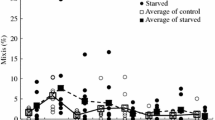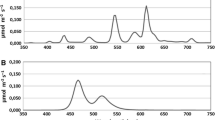Abstract
We examined the effect of low temperature treatment(12°C), followed by transfer to highertemperature (25°C), on resting egg formation ofthe rotifer Brachionus plicatilis, Kamiurastrain. This strain has been mass cultured as livefeed at Kamiura Station (Japan Sea FarmingAssociation) for 9 years at 20°C without theappearance of sexual reproductive stages.After preculture in 20 l of 27‰ seawater at 12°C for 0, 10, 20, and 30 days,rotifers were inoculated into 0.5 l mass cultures andcultured at 25°C for 7–9 days. The inoculationdensities were changed from 20 to 400 ind. ml−1,depending on mixis rate. Condensed and frozen Nannochloropsis oculata was fed to rotifers at thefeeding rate of 0.14 µg (dry weight)rotifer−1day−1. The control was cultured at12°C for the entire 36 day experiment. No mixisappeared and no resting eggs were produced when thelow temperature treatment was 0 or 10 days. However,mixis rates reached 50-60% after 20 or 30 days ofexposure to 12°C. The number of resting eggsproduced in these treatments reached 25,500 about 13 times higher than the control. Our resultssuggest that low temperature stimulated mictic femaleproduction and the transfer to the high temperatureaccelerated resting egg formation. This method may beuseful for producing resting eggs of rotifer strainsthat lack sexual reproduction in the common culturecondition at larval rearing facilities.
Similar content being viewed by others
References
Hagiwara, A., 1994. Practical use of rotifer cysts. Israel J. Aquacult. Bamidgeh 46: 13–21.
Hagiwara, A. & K. Hirayama, 1993. Preservation of rotifers and its application in the finfish hatchery. In C. S. Lee, M. S. Su & I. C. Liao (eds), Proc. Finfish Hatchery in Asia ’91. TML Conference Proceeding 3. Tungkang Marine Laboratory, Taiwan Fisheries Research Institute, Tungkang, Taiwan: 61–71.
Hagiwara, A. & C.-S. Lee, 1991. Resting egg formation of the L-and S-type rotifer Brachionus plicatilisunder different water temperature. Nippon Suisan Gakkaishi 57: 1645–1650.
Hagiwara, A., A. Hino & R. Hirano, 1988a. Effects of temperature and chlorinity on resting egg formation in the rotifer Brachionus plicatilis. Nippon Suisan Gakkaishi 54: 569–575.
Hagiwara, A., A. Hino & R. Hirano, 1988b. Comparison of resting egg formation among five Japanese stocks of the rotifer Brachionus plicatilis. Nippon Suisan Gakkaishi 54: 577–580.
Hagiwara, A., M. D. Balompapueng, N. Munuswamy & K. Hirayama, 1997. Mass production and preservation of the euryhaline rotifer (Brachionus plicatilisand B. rotundiformis) resting eggs. Aquaculture, in press.
Hagiwara, A., K. Hamada, S. Hori, & K. Hirayama, 1994. Increased sexual reproduction in Brachionus plicatilis(Rotifera) with the addition of bacteria and rotifer extracts. J. exp. mar. Biol. Ecol. 181: 1–8.
Hagiwara, A., K. Hamada, A. Nishi, K. Imaizumi & K. Hirayama, 1993. Mass production of rotifer Brachionus plicatilisresting eggs in 50m3 tanks. Nippon Suisan Gakkaishi 59: 93–98.
Hino, A., 1993. Present culture systems of the rotifer Brachionus plicatilisand the function of microorganisms. In C. S. Lee, M. S. Su & I. C. Liao (eds), Proc. Finfish Hatchery in Asia ’91. TML Conference Proceeding 3. Tungkang Marine Laboratory, Taiwan Fisheries Research Institute, Tungkang, Taiwan: 51–59.
Hino, A. & R. Hirano, 1976. Ecological studies on the mechanism of bisexual reproduction in the rotifer Brachionus plicatilis. I.General aspects of bisexual reproduction. Nippon Suisan Gakkaishi 42: 1093–1099.
Hirayama, K. & T. Kusano, 1972. Fundamental studies on physiology of rotifer for its mass culture-II. Influence of water temperature on population growth of rotifer. Nippon Suisan Gakkaishi 38: 1357–1363.
Imamura, S., S. Ashidate & H. Tojo, 1979. Mass formation of Brachionus plicatilisresting eggs with a stimulus of temperature. Tech. Rep. Jap. Sea Ranching Programs 8: 53–61. (In Japanese).
Rumengan, I. F. M. & K. Hirayama, 1990. Growth responses of genetically distinct S and L type rotifer (Brachionus plicatilis) strains to different temperatures. Proc. 2nd Asian Fish. Forum: 37–40.
Author information
Authors and Affiliations
Rights and permissions
About this article
Cite this article
Kogane, T., Hagiwara, A. & Imaizumi, K. Temperature conditions enhancing resting egg production of the euryhaline rotifer Brachionus plicatilis O. F. Müller (Kamiura strain). Hydrobiologia 358, 167–171 (1997). https://doi.org/10.1023/A:1003180818806
Issue Date:
DOI: https://doi.org/10.1023/A:1003180818806




